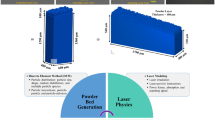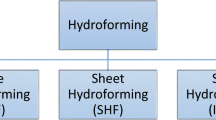Abstract
This paper describes a 3D finite element model used for optimizing the deep-drawing formability of a commercially pure titanium cap designed for the cosmetic industry. The results obtained from a specific tooling and various tensile tests highlight a strong anisotropic behavior of the material (earing profile on the parts and Lankford coefficients very sensitive to the loading direction). The mechanical behavior taking this anisotropy into account is described according to an elastic-plastic model based on the quadratic Hill’s criterion. A special attention is paid to studying the sensitivity of the FEM predictions with respect to the numerical parameters. The type and number of elements in the thickness of the blank and the friction coefficient have a significant influence on the numerical results. The comparison with the experiments taking the springback into account shows that the FE model is suitable for describing the behavior of titanium during a forming process such as deep-drawing. A Forming Limit Diagram is finally given to predict the feasibility and optimize the forming operation.














Similar content being viewed by others
Notes
processor: 3GHz, RAM: 512 Mo.
References
Fundenberger JJ, Philippe MJ, Wagner F, Esling C (1997) Modelling and prediction of mechanical properties for materials with hexagonal symmetry (zinc, titanium and zirconium alloys). Acta Mater 45:4041–4055
Stevenson R, Breedisu JF (1975) Cyclic deformation of commercial-purity titanium. Acta Metall 23:1419–1429
Tomé CN, Maudlin PJ, Lebensohn RA, Kaschner GC (2001) Mechanical response of zirconium I. Derivation of a polycrystal constitutive law and finite element analysis. Acta Mater 49:3085–3096
Chen F-K, Chiu K-H (2005) Stamping formability of pure titanium sheets. J Mater Process Technol 170:181–186
Hill R (1948) A theory of the yielding and plastic flow of anisotropic metals. Proc R Soc Lond A193:281–297
Flores P, Duchêne L, Bouffioux C, Lelotte T, Henrard C, Pernin N, Van Bael A, He S, Duflou J, Habraken AM (2007) Model identification and FE simulations: effect of different yield loci and hardening laws in sheet forming. Int J Plast 23:420–449
Duchêne L, Habraken AM (2005) Analysis of the sensitivity of FEM predictions to numerical parameters in deep drawing simulations. Eur J Mech A Solids 24:614–629
Vacher P, Dumoulin S, Morestin F, Mguil-Touchal S (1999) Bidimensional strain measurement using digital images. Proc Inst Mech Eng 213:811–817
Toussaint F, Tabourot L, Ducher F (2008) Experimental and numerical analysis of the forming process of a CP titanium scoliotic instrumentation. J Mater Process Technol 197:10–16
Rasmussen KJR, Burns T, Bezkorovainy P, Bambach MR (2003) Numerical modelling of stainless steel plates in compression. J Constr Steel Res 59:1345–1362
Xu WL, Ma CH, Li CH, Feng WJ (2004) Sensitive factors in springback simulation for sheet metal forming. J Mater Process Technol 151:217–222
Wagoner RH, Li M (2007) Simulation of springback: through-thickness integration. Int J Plast 23:345–360
Meinders T, Burchitz IA, Bonte MHA, Lingbeek RA (2008) Numerical product design: springback prediction, compensation and optimization. Int J Mach Tools Manuf 48:499–514
Krol S, Zalisz Z, Hepner M (2005) Comparison of the friction and wear properties of titanium and oxidised titanium in dry sliding against sintered high speed steel HS18-0-1 and against C45 carbon steel. J Mater Process Technol 164–165:868–875
Lingbeek R, Huétink J, Ohnimus S, Petzoldt M, Weiher J (2005) The development of a finite elements based springback compensation tool for sheet metal products. J Mater Process Technol 169:115–125
Vacher P, Haddad A, Arrieux R (1999) Determination of the forming limit diagrams using image analysis by the corelation method. CIRP Ann 48:227–230
Shim H, Son K, Kim K (2000) Optimum blank shape design by sensitivity analysis. J Mater Process Technol 104:191–199
Vahdat V, Santhanam S, Chun YW (2006) A numerical investigation on the use of drawbeads to minimize ear formation in deep drawing. J Mater Process Technol 176:70–76
Pegada V, Chun Y, Santhanam S (2002) An algorithm for determining the optimal blank shape for the deep drawing of aluminium cups. J Mater Process Technol 125–126:743–750
Author information
Authors and Affiliations
Corresponding author
Rights and permissions
About this article
Cite this article
Le Port, A., Toussaint, F. & Arrieux, R. Finite element study and sensitive analysis of the deep-drawing formability of commercially pure titanium. Int J Mater Form 2, 121–129 (2009). https://doi.org/10.1007/s12289-009-0398-8
Received:
Accepted:
Published:
Issue Date:
DOI: https://doi.org/10.1007/s12289-009-0398-8




